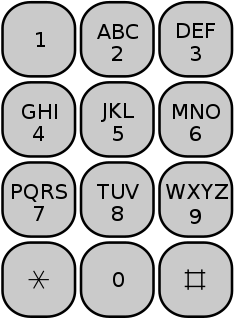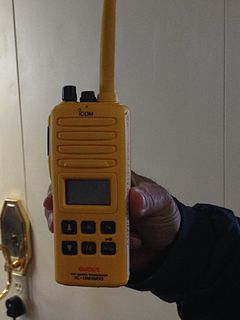This article needs additional citations for verification .(September 2012) (Learn how and when to remove this template message) |

Inmarsat-C is a two-way, packet data service operated by the telecommunications company Inmarsat which operates between mobile earth stations (MES) and land earth stations (LES). It became fully operational after a period of pre-operational trials in January 1991. The advantages of Inmarsat-C compared to Inmarsat-A are low cost, smaller and uses a smaller omni-directional antenna. The disadvantage is that voice communication is not possible with Inmarsat-C. [1] The service is approved for use under the Global Maritime Distress and Safety System (GMDSS), meets the requirements for Ship Security Alert Systems (SSAS) defined by the International Maritime Organization (IMO) and is the most widely used service in fishing Vessel Monitoring Systems (VMS).

Inmarsat plc is a British satellite telecommunications company, offering global mobile services. It provides telephone and data services to users worldwide, via portable or mobile terminals which communicate with ground stations through thirteen geostationary telecommunications satellites. Inmarsat's network provides communications services to a range of governments, aid agencies, media outlets and businesses with a need to communicate in remote regions or where there is no reliable terrestrial network. The company is listed on the London Stock Exchange, is a constituent of the FTSE 250 Index, and is a financial and technical sponsor of Télécoms Sans Frontières.
The Ship Security Alert System (SSAS) is part of the ISPS code and is a system that contributes to the International Maritime Organization's (IMO)'s efforts to strengthen maritime security and suppress acts of terrorism and piracy against shipping. The system is an IMO regulated system. In case of attempted piracy or terrorism, the ship's SSAS beacon can be activated, and appropriate law-enforcement or military forces can be dispatched. An SSAS beacon operates with similar principles to the aircraft transponder emergency code 7700.

The International Maritime Organization (IMO), known as the Inter-Governmental Maritime Consultative Organization (IMCO) until 1982, is a specialised agency of the United Nations responsible for regulating shipping. The IMO was established following agreement at a UN conference held in Geneva in 1948 and the IMO came into existence ten years later, meeting for the first time in 1959. Headquartered in London, United Kingdom, the IMO currently has 174 member states and three associate members.
Contents
The service works with a store-and-forward method which enables interface with data network transfer including; e-mail; SMS; telex; remote monitoring; tracking (position reporting); chart and weather updates; maritime safety information (MSI); maritime security; GMDSS; and SafetyNET [2] and FleetNET services; two-way messaging; data reporting and polling; Safety/Emergency alerting.

SMS is a text messaging service component of most telephone, internet, and mobile-device systems. It uses standardized communication protocols to enable mobile devices to exchange short text messages. An intermediary service can facilitate a text-to-voice conversion to be sent to landlines. SMS was the most widely used data application at the end of 2010, with an estimated 3.5 billion active users, or about 80% of all mobile subscribers.
Data reporting is the process of collecting and submitting data which gives rise to accurate analyses of the facts on the ground; inaccurate data reporting can lead to vastly uninformed decision-making based on erroneous evidence. When data is not reported, the problem is known as underreporting; the opposite problem leads to false positives.
The service is operated via an Inmarsat-C Transceiver or a lower-power mini-C Transceiver. Data transfers between MES and LES at a rate of 600 bits/second. The frequencies for transmitting (TX) are 1626.5MHz -1645.5MHz and for receiving (RX) are 1530.0MHz - 1545.0MHz.
The service is available for maritime, land mobile and aeronautical use.
This system was also used to track the BBC's project "The Box". [3] BBC News followed a container around the world for a year to tell stories of globalization and the world economy.

The Box or BBC Box is a single ISO intermodal container that started to be tracked by BBC News in September 2008. The intention was to track the container for a period of one year, in a project to study international trade and globalisation. The Box was fitted with tracking equipment and painted in a special one-off livery.

An intermodal container is a large standardized shipping container, designed and built for intermodal freight transport, meaning these containers can be used across different modes of transport – from ship to rail to truck – without unloading and reloading their cargo. Intermodal containers are primarily used to store and transport materials and products efficiently and securely in the global containerized intermodal freight transport system, but smaller numbers are in regional use as well. These containers are known under a number of names, such as simply container, cargo or freight container, ISO container, shipping, sea or ocean container, sea van or (Conex) box, sea can or c can.







